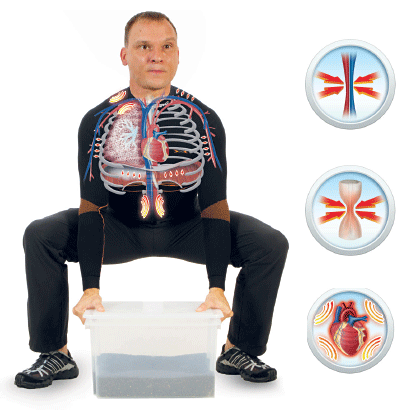In everyday life, forced expiration is often applied unconsciously; one takes a deep breath and "pretends" to exhale but in fact holds one's breath (pressing). Then, one performs an extremely strenuous movement (e.g. opening a jam jar, lifting a beverage crate). Closing the airways and tensing the respiratory and abdominal muscles as well as the force transmitted by the working muscles put a high pressure on the rib cage which is then transferred to the organs in the rib cage. Those overlaying pressures trigger the responses described in the following illustration.
| Forced expiration | |
|---|---|
 |
Blood circulations: The blood vessels in the pulmonary circulation and in the systemic circulation are constricted or compressed. This compression itself and different standard processes after maximum exertion have a strong impact on blood pressure. Peak pressures develop and considerable blood pressure variations occur due to the sudden relief after exertion. Patients with pulmonary hypertension need to be especially cautious. Peak blood pressures are transmitted and can cause damaged vessels to rupture. Lungs: Airways are compressed. Thus, the possible amount of air (ventilation) during exertion is reduced and performance is limited. Furthermore, the pressure in the lung (keyword: pulmonary hypertension) increases. |
| Heart: The heart must work harder in order to pump the blood through the narrowed/compressed blood vessels. The right heart especially, which is often damaged with COPD (cor pulmonale), is at risk of being overstrained (decompensation). Moreover, the blood supply of organs itself is restricted. In total, there are wild fluctuations in the pump efficiency of the heart (how much blood is ejected and how many times does the heart beat = ejected amount and heart rate). | |
| Practical examples: | |
|---|---|
| Going into forced expiration: This happens with increasing fatigue especially towards the end of a given number of repetitions. | |
| Going a little into forced expiration: This happens automatically when performing with less repetitions and heavy weights. The muscle tension which is necessary to overcome the work load produces pressure. One is able to exhale in a relatively controlled manner but there is already high pressure in the rib cage. | |
| Holding one's breath (pressing intentionally): This happens automatically as soon as the weight/ load becomes very heavy/maximum. Examples: lifting a bag of cement, opening a jam jar, loosening a bolt with a wheel wench when changing tyres. In the context of COPD, forced expiration can be triggered by incorrect body postures (e.g. putting on shoes or different start or end positions in strength training). | |
| By applying forced expiration you might have a little more strength but this has its costs as shown above. During a training session, it is recommended to check the blood pressure repeatedly and to be aware of any symptoms (cf. the following chapter). The work rate in general should be lower if there are any comorbidities as e.g. hypertension, cor pulmonale and other coronary diseases, diabetes (keyword: intraocular tension), PAOD and the acute period that follows pneumonia and pneumothorax. Therefore, it is absolutely necessary to consult with your doctor. | |